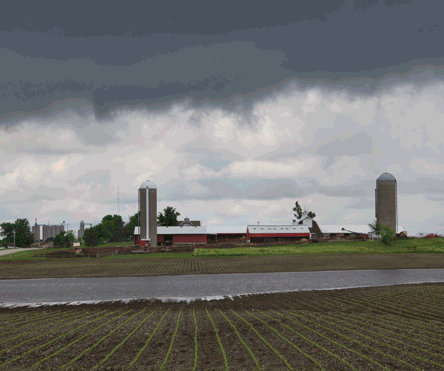A muddy mess of a planting season
Author
Published
6/6/2013

For most Iowa farmers, the spring of 2013 has been one of the most frustrating and difficult planting seasons in memory. And, unless conditions shift in a hurry, the wet conditions this spring are likely to have reverberations for farmers and consumers for months and years to come.
The wet spring has mostly been a nuisance for those of us who live in town. Maybe, it’s a wet basement, or a stalled flower garden, or a lawnmower that breaks down because we have to fire it up every other day.
But for farmers, the rainiest spring in Iowa’s history has severely delayed planting of corn and soybeans fields. That, experts say, is almost certain to dampen harvest prospects this fall. And with crop stockpiles at extremely low levels already, a smaller harvest could lead to continued cost pressure for livestock farmers, food processors and others who rely on corn and soybeans. Consumers too may feel the pinch from higher prices for meat and other products at the supermarket.
Here is the official USDA report, which shows how the wet fields have delayed Iowa’s planting progress this spring.
The recurrent rain storms have turned fields, which were bone-dry through the winter, into wet and muddy swamps. That’s forcing farmers to make some very tough decisions as the calendar flips forward to mid-June.
Some farmers are trying to determine whether to keep trying to plant corn. Yield expectations decline for corn fields planted after June 1 and fall off sharply as the month progresses. Iowa State University agronomists say that farmers who plant corn after June 7 can expect only 70 percent of the yield potential of those planted on time, and by June 15 potential drops to 50 percent.
Soybeans mature in a shorter amount of time and can be planted later. But soybeans generally don’t have the income potential of corn, and soybean fields planted in June also tend to suffer yield declines compared to those planted earlier.
Even farmers with their fields planted can’t rest easy this spring. The heavy rains have left shallow ponds in many fields and the standing water could drown the young plants and force farmers to replant. And the risk of crop diseases tend to rise during wet years like this one is shaping up to be, so fields will likely need more intensive care this growing season.
In the end, a year that farmers hoped would help them recover from last year’s severe drought is not starting out well at all.
Sure, farming is always risky and Iowa weather can often be erratic. But to go from drought one year to this, that’s almost unbelievable. As one northwest Iowa farmer said as he watched a normally placid creek on his place become a raging river: “Last summer, I saw the bottom of creek beds I’ve never seen before. It’s definitely turned around.”
Written by Dirck Steimel. Dirck is the editor of the Iowa Farm Bureau Spokesman.